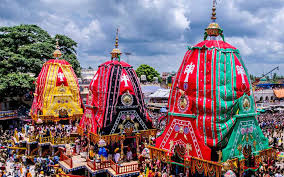BHUBANESWAR: The spectacular Rath Yatra is perhaps the greatest celebration in Odisha. Its impact is far reaching. The chariot is a recurring motif of Odisha’s traditional art. The most remarkable example one can think of is the Sun Temple of Konark, with its 24 wheels and majestic horses pulling the temple conceived as Surya’s chariot. While everyone knows about Puri Rath Yatra, Odisha actually has four huge chariot festivals every year. The four places are shaped like the four attributes of Vishnu: Sankha (conch), Chakra (wheel), Gada (mace) and Padma (lotus).
Puri is called Sankha Khetra, Bhubaneswar Chakra Khetra, Jajpur Gada Khetra and Konarka Padma Khetra. These shrines have nurtured four different sects from time immemorial, the followers of Vishnu, Shiva, Shakti and Surya respectively.
Lingaraj
The chariot of Lingaraja in Bhubaneswar is known as the Rukuna Ratha. Some scholars believe this festival predates even the Puri one.
‘Rukuna’ is a colloquial variant of the word Rukmini. But why is Shiva’s chariot named after Vishnu’s consort? Nobody knows for sure. Today, Lingaraja, Rukmini and Ananta Basudeba are taken in the chariot in a striking resemblance to the Puri triad.
Biraja
Jajpur’s goddess shrine is one of the most ancient shrines of Odisha. Biraja’s chariot is called Singhadhwaja ‘lion-bannered’. The event lasts nine days. The chariot here has no destination, in sharp contrast to the other chariots (notably this is the only feminine deity with a chariot). Instead, it circumambulates the temple itself. The path is circular, looping back into itself, not linear.
Given the Tantric background of this place and the geometrical symbolism so commonly employed there, it is probably a metaphor for the goddess, symbolising feminine power, grace and nature itself.
Konark
Most of the history of the grand sun temple of Konark (originally called Padmakesara Deula) is an enigma. However, the discovery and subsequent publication of four manuscripts on the shrine by Pt. Sadasiva Rathasarma of Puri along with Alice Boner in the 1970s revealed fascinating details.
From these, we find details of how the Sun Temple had its own chariot festival. On the day of magha sukla saptami (considered to be the birthday of the deity) a ratha was made. The book of chronicles mentions that artisans from Puri would come over for this. On the chariot a small bronze image of the deity was placed. The god was thus taken from a chariot-like temple to a temple-like chariot, reiterating that the ratha is meant to be nothing, but a movable temple.
Puri
The grandest of all, Puri’s Rath Yatra, was and still is the most famous chariot festival. Perhaps, the earliest representation in sculpture comes from a frieze originally in a temple at Dhanmandal in Odisha.
It shows three chariots with deities being pulled by devotees. However, these rathas are pyramidal — modelled after the pyramidal pidha deula of Kalinga architecture. They have solid wheels. The wheels have spokes like those at Konarka. We now have three rathas instead of six, which was the norm when the Malini River flowed across Badadanda. Many details evolved in course of time, but the ritual continues as always, untarnished.
Prateek Pattanaik
